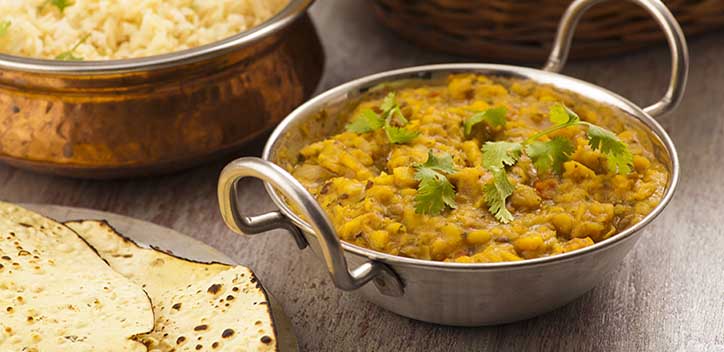Rosamund Raha shares her important tips when trying to recreate great-tasting Bengali cuisine to impress your friends and family with.
Some cooks follow recipes to the letter while others like to throw ingredients together and experiment. It is good to develop both skills, because they both have an important role to play for anyone who wants to increase their culinary repertoire. Bengali home cooking lends itself well to the experimental approach, so why not give it a try?!
Follow these simple guidelines to make delicious, well-balanced, vegan Bengali meals. No recipes are needed (except for the breads and puris), so long as you vary the spices (particularly the aromatic spices) used in each dish. These are techniques taught to me by the Bengali part of my family but of course, methods vary from person to person, as Bengalis (like all people) regularly experiment with different techniques.
In most parts of India, when you offer a meal to guests, you would usually offer many different items at one meal; this is particularly the case in West Bengal. These items are usually eaten one at a time, with rice or breads such as chapatis, parathas, naan or puris, but they can sometimes be mixed; a fairly bland dahl mixed with rice can be eaten with a spicy vegetable dish for example. A dahl would normally be served as part of each meal.
Different aromatic spices are used for each dish, so that all the dishes have a distinct flavour. However, the base spices are often similar in each dish. For example, haldi (turmeric) is used in most dishes as it gives a lovely golden colour and aids digestion. Jeera (cumin) is also used in most dishes. Some other base spices used in many dishes are chilli powder (or chopped fresh chillies), dhaniya (ground coriander), curry leaves, mustard seed, poppy seed, ginger and garlic.
Aromatics are fennel seed, five spice, cinnamon (in the form of woody sticks), methi (fenugreek), cloves, cardamom pods and nutmeg. When using five spice, it is a good idea to fry it in a little hot *rapeseed oil for a few minutes first before adding vegetables to the pan for more gentle frying.
Tamarind and amchoor (mango powder) can also be added to the dishes in small quantities to add a ‘bitter’ taste; mustard is sometimes used, and slices of lemon are usually available on the table to add an optional piquancy to the dish.
As with many Western dishes, most dishes start with frying onion or other vegetables in oil, but a little more oil than usual is needed, as you will also be adding most of the spices at this stage. For four people, you would generally use about a level teaspoonful of each powdered spice (less in the case of chilli powder!). Salt (to taste) and other vegetables or lentils are added after the onions have softened. These are then cooked in the normal way with water added as necessary. Other aromatic spices such as garam masala and fresh coriander leaf may be stirred in at the very end because they lose their aroma and flavour if they are added too early.
 Top Tip: to make a dahl extra tasty, it is good to add something called a shambash. Cook the lentils (preferably moong dahl, channa dahl or the small orange lentils which you can buy in any supermarket) in water with a little ginger, and salt. Then in a separate pan shallow fry some chopped chillies (optional), chopped or crushed garlic, haldi, methi and jeera in rapeseed oil.
Top Tip: to make a dahl extra tasty, it is good to add something called a shambash. Cook the lentils (preferably moong dahl, channa dahl or the small orange lentils which you can buy in any supermarket) in water with a little ginger, and salt. Then in a separate pan shallow fry some chopped chillies (optional), chopped or crushed garlic, haldi, methi and jeera in rapeseed oil.
When the spices are cooked, pour the oil and spices into the lentil dahl. This will make a really delicious dahl.
You can experiment with different vegetable combinations, but some good ones are:
- bringal (aubergine) fried with potato cubes and spices
- cauliflower fried with potato cubes and spices
- chick pea and onion
- chickpea and spinach
- fine beans, steamed and then briefly fried with a little oil and mustard (although it’s not Indian you can use Dijon mustard);
- courgette, marrow or squash with onion (Bengalis would probably use a radish type vegetable called mouli, but courgette, marrow or squash are just as good)
- mixed vegetable curry (use pretty much any vegetables).
Where potato cubes are used they should be washed and dried after being cut up so that the starch does not make the cubes stick to the bottom of the pan, and some water will need to be added after you initially fry the potatoes and other vegetables.
*Rapeseed oil would not generally be used in India, but it is the best oil to cook with when frying to provide us with omega 3. Refined rapeseed oil that you can buy cheaply in the supermarket is stable at high temperatures.
Furthermore, all these spices are available from Indian supermarkets and most can be obtained from ordinary supermarkets and health food shops. I hope you have fun cooking these great new meals the Bengali way!
By Rosamund Raha
Would you like to write for our blog? Read our guidelines then email web[at]vegansociety[dot]com with your pitch!
The views expressed by our bloggers are not necessarily the views of The Vegan Society.

